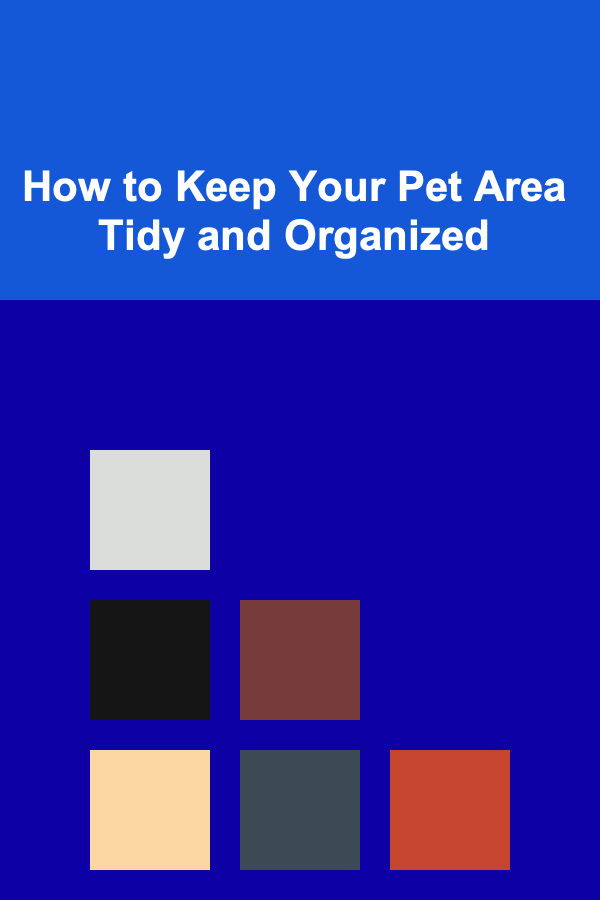
How to Keep Your Pet Area Tidy and Organized
ebook include PDF & Audio bundle (Micro Guide)
$12.99$6.99
Limited Time Offer! Order within the next:

Creating a tidy and organized pet area is essential for both the comfort of your furry friend and the ease of maintaining cleanliness in your home. Pets bring joy and companionship, but they can also add a layer of complexity when it comes to managing their belongings and keeping their spaces clean. In this comprehensive guide, we will explore effective strategies for organizing your pet area, maintaining tidiness, and ensuring a harmonious living environment for both you and your pet.
The Importance of an Organized Pet Area
1. Promotes Hygiene
A well-organized pet area contributes to better hygiene. Regular cleaning becomes easier when everything is in its designated place, reducing the likelihood of odors and messes.
2. Enhances Safety
Proper organization helps prevent accidents. Keeping pet supplies out of reach and storing them safely reduces the risk of ingestion or injury.
3. Saves Time
An organized space allows for quick access to pet supplies, making routines such as feeding, grooming, and cleanup much faster and more efficient.
4. Improves Aesthetics
A tidy pet area is visually appealing and contributes to the overall ambiance of your home. It eliminates clutter that may detract from your decor and creates a pleasant environment.
5. Encourages Responsibility
A well-maintained pet area encourages family members, especially children, to take responsibility for pet care, teaching valuable life skills.
Steps to Organize Your Pet Area
Follow these steps to create an organized and tidy pet area that works for you and your pet.
Step 1: Assess Your Current Setup
Before diving into organization, assess your current pet area. Consider the following questions:
- Is the area cluttered with toys, food, and supplies?
- Are items easy to find when needed?
- Is there a designated space for each type of pet supply?
Take notes on what works well and what needs improvement.
Step 2: Declutter
Decluttering is the first essential step in creating an efficient pet area. Here's how to get started:
A. Gather All Supplies
Collect all pet-related items in one place, including food, toys, grooming tools, and accessories. This process helps you see exactly what you have.
B. Sort Items
Divide items into categories such as:
- Food and Treats
- Toys
- Grooming Supplies
- Bedding and Accessories
- Health and Medications
C. Make Decisions
Evaluate each item and decide whether to keep, donate, or throw it away. Ask yourself:
- Is it still functional?
- Does my pet use it regularly?
- Is it safe and in good condition?
Use the "one in, one out" rule: for every new item you bring in, consider removing an old one.
Step 3: Designate a Pet Area
Identify a specific area in your home for your pet's supplies. This could be a corner of a room, a designated shelf, or even a separate room if space permits. Factors to consider include:
- Space Availability: Ensure there is enough space for all supplies while allowing room for your pet to move.
- Accessibility: Choose a location that is easily accessible for both you and your pet, particularly for feeding and grooming.
Step 4: Choose Storage Solutions
Utilize appropriate storage solutions that fit your space and style. Here are some options to consider:
A. Baskets and Bins
- Use decorative baskets or bins for storing toys. Choose clear or labeled containers for easy identification.
- Opt for collapsible storage bins that can be tucked away when not in use.
B. Shelving Units
Install shelving units to store food, treats, and grooming supplies. Utilize vertical space to keep items organized and off the floor.
C. Drawer Organizers
If you have drawers available, use drawer organizers to separate grooming tools, leashes, and collars. This method keeps smaller items from getting lost.
D. Wall-Mounted Organizers
Consider wall-mounted racks for leashes, harnesses, and bags. Hooks or pegboards can also work for hanging items, saving floor space.
Step 5: Create a Cleaning Routine
Maintaining a tidy pet area requires regular upkeep. Establish a cleaning routine that includes:
A. Daily Tasks
- Pick Up Toys: Encourage the habit of putting toys back in their designated storage at the end of each day.
- Wipe Down Surfaces: Clean food and water bowls daily to maintain hygiene.
B. Weekly Tasks
- Dust and Vacuum: Dust surfaces and vacuum areas where pet hair accumulates. Use a handheld vacuum specifically designed for pet hair.
- Wash Bedding: Clean pet bedding according to the manufacturer's instructions to eliminate odors and allergens.
C. Monthly Deep Cleaning
Once a month, conduct a thorough deep clean of the pet area. This should include:
- Disinfecting bowls and toys
- Washing any washable storage bins or baskets
- Organizing supplies and decluttering as necessary
Step 6: Personalize the Space
While functionality is key, personalizing your pet area can make it more inviting. Here are some ideas:
- Decorative Touches: Add decorative elements like pet-themed artwork or photographs of your pets.
- Comfortable Bedding: Invest in quality bedding or pet beds that complement your home decor.
- Stylish Containers: Choose stylish storage solutions that blend well with your interior design.
Step 7: Involve Family Members
Getting everyone involved in maintaining the pet area fosters responsibility and teamwork. Assign tasks to family members based on age and ability:
- Children: Older kids can help with feeding, toy pickup, and light cleaning.
- Adults: Adults can manage deeper cleaning tasks, shopping for supplies, and organizing.
Step 8: Adapt and Adjust
Life changes, and so do your pet's needs and activities. Regularly reassess your organization system to ensure it remains effective:
- Are there new toys or supplies that need to be accommodated?
- Has your pet's routine changed, requiring adjustments to the space?
- Do you need additional storage solutions due to accumulated items?
Tips for Maintaining an Organized Pet Area
To sustain a tidy and organized pet area, consider these additional tips:
1. Use Labels
Label storage bins, shelves, and baskets to facilitate quick identification. Clear labeling helps everyone in the household know where items belong.
2. Create a Schedule
If you have multiple pets, consider creating a schedule for feeding and grooming. This approach ensures that each pet receives individual attention and care.
3. Keep Essentials Handy
Store essential items, such as leashes, waste bags, and grooming tools, in a convenient location near the door for easy access during walks or outings.
4. Rotate Toys
To prevent boredom, rotate your pet's toys regularly. This strategy keeps their interest alive and minimizes clutter in the play area.
5. Stay Consistent
Consistency is crucial for maintaining organization. Encourage everyone in the household to follow the established cleaning and organizing routines.
Common Challenges and Solutions
As with any organizational system, challenges may arise. Here are some common issues along with potential solutions:
Challenge 1: Overwhelming Clutter
Solution: If your pet area feels cluttered, break down the decluttering process. Focus on one section at a time to avoid feeling overwhelmed.
Challenge 2: Resistance from Pets
Solution: Some pets may resist changes to their space. Introduce new storage solutions gradually and allow your pet to explore their area before fully integrating changes.
Challenge 3: Limited Space
Solution: Get creative with storage solutions. Utilize vertical space, under-bed storage, or multifunctional furniture to maximize space efficiency.
Challenge 4: Frequent Messes
Solution: Implement preventive measures, such as using washable covers on furniture, investing in machines designed to remove pet hair, or keeping cleaning supplies readily available.
Real-Life Examples of Organized Pet Areas
To inspire your organizational journey, here are a few real-life examples showcasing effective strategies:
Example 1: The Small Apartment Pet Area
In a small apartment, pet owners use vertical shelving to keep cat toys and supplies neatly organized. Wall-mounted hooks hold leashes, while a compact bin stores food and treats. This setup maximizes limited square footage while keeping everything tidy.
Example 2: The Family-Friendly Pet Space
A family with multiple pets has dedicated zones for each animal. Each zone contains personalized baskets for toys, food, and grooming supplies. Color-coded labels help children locate items quickly, promoting engagement in pet care.
Example 3: The Stylish Pet Corner
In a modern home, a pet corner features a chic pet bed and stylish storage solutions that match the home decor. Decorative baskets house toys, while a curated selection of pet-friendly books adds fun flair to the space.
Conclusion
Keeping your pet area tidy and organized requires intentionality, consistency, and care. By following the steps outlined in this guide---from assessing your current setup to incorporating smart storage solutions---you can create a functional, inviting space that enhances your pet's comfort and wellbeing.
Remember that maintaining an organized pet area is an ongoing process. Regularly reassess your system, involve family members, and adapt to changing needs. With the right strategies, you can enjoy a clean and harmonious home that reflects your love for your pets. Happy organizing!
Reading More From Our Other Websites
- [Biking 101] How to Choose the Best Bike Pedals for Your Riding Style
- [Beachcombing Tip 101] 10 Essential Tips for Beginner Shell Collectors: From Beach Walks to Storage
- [Home Security 101] How to Make Your Home Safer with Motion Detectors: A Step-by-Step Guide
- [Organization Tip 101] How to Organize Your Home Security Records
- [Organization Tip 101] How to Use Open Shelving for Stylish Organization
- [Home Party Planning 101] How to Build a Killer Party Playlist for a Good Vibe: Genre, Flow, and Avoiding the Awkward Silence
- [Gardening 101] Eco‑Friendly Garden Edging: Sustainable Options for Green Gardens
- [Star Gazing Tip 101] Myths Written in Constellations: Storytelling Through the Heavens in Antiquity
- [Organization Tip 101] How to Create a Weekly Meal Planning System
- [Tiny Home Living Tip 101] How to Furnish a Tiny Home Living Room with Multi‑Purpose Pieces

Building Stronger Healthcare Teams: A Practical Handbook for Healthcare Consultants
Read More
How To Build a Community as a Digital Nomad
Read More
How to Create a Warm and Inviting Holiday Entryway
Read More
How to Declutter Pet Supplies Regularly
Read More
How to Set Up a Pet-Friendly Outdoor Space in Your Backyard
Read More
How To Leverage User-Generated Content for POD Marketing
Read MoreOther Products

Building Stronger Healthcare Teams: A Practical Handbook for Healthcare Consultants
Read More
How To Build a Community as a Digital Nomad
Read More
How to Create a Warm and Inviting Holiday Entryway
Read More
How to Declutter Pet Supplies Regularly
Read More
How to Set Up a Pet-Friendly Outdoor Space in Your Backyard
Read More